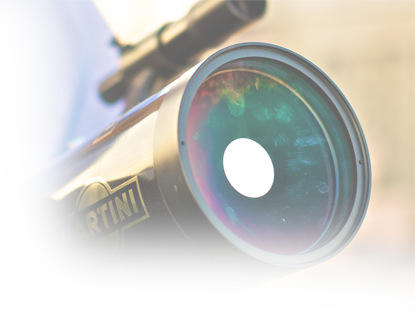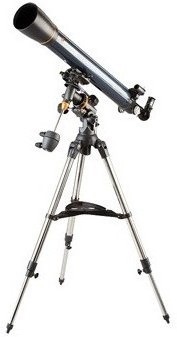

How to choose a telescope
Are you interested in astronomy? Do you want to uncover the celestial wonders? The astronomical telescope is an optical instrument designed for observation of celestial objects such as stars, nebulae, planets, and the Moon. Read on for a few tips how to choose the right telescope for you.

Frequently asked questions when choosing a telescope
What aperture should I start with?
Beginners are generally advised to start with a smaller telescope, with an aperture of 70-100 mm and an azimuth mount. These telescopes are less expensive and it can serve you in the future as a portable travel telescope as well. In the higher price range, you can find more powerful devices, such as a Newtonian telescope with an aperture of 150-200 mm. If you are willing to pay extra for comfort, you can get an electronically guided mount.
What can I see with a telescope?
Even a small astronomical telescope with a 60 mm aperture and 50× zoom is powerful enough to show you the craters on the Moon, the largest moons of Jupiter, or the rings around Saturn. With a 150 × magnification you can see Saturn's rings in detail. At that point, however, you need a larger telescope, because the maximum useful magnification of the telescope is about twice its aperture in millimetres. To put it in more concrete numbers, a telescope with a 100 mm aperture can deliver real magnification of about 200×. Theoretically, you could get more by adding an appropriate eyepiece, but the image would be dark and with less contrast.
What care and maintenance does a telescope need?
Use the caps to protect the telescope optics against dust. Do not touch the optical surfaces of the device. Clean them only when necessary and always in accordance with the manufacturer's advice as stated in the instruction manual.
Never try to repair the telescope yourself. If you are not particularly familiar with optical systems or don’t understand the instructions exactly, make sure to contact a professional.
You can use your telescope to observe the sky from your garden, balcony, or terrace, but it will require a great deal of patience. Buildings radiate heat, which hampers the observation. You have to give the telescope optics time to adjust to the outdoor air temperature. In winter, this temperature adjustment takes longer than in summer.
Don’t forget that the observer's eyes must adapt to darkness as well. It takes the human eye several dozens of minutes to adapt to the dark properly.
Important Parameters


Diameter
Larger diameter telescopes allow you to observe fainter and more distant objects.
Smaller diameter telescopes - can be used to observe the Moon, planets, or the solar photosphere.
Larger diameter telescopes - suitable for observing nebulae, galaxies, and star constellations
Generally speaking, a larger telescope diameter means higher aperture, better brightness, and higher magnification. The lens or mirror diameter is therefore crucial.

Focal length
Another important factor is the focal length, which is usually listed on the tube. On the eyepiece you can also find the focal length of the eyepiece, for example 1000/10 = 100×. This means that if a telescope has a focal length of 1000 mm and a 10 mm eyepiece, the magnification is 100×. If the focal length remains the same and you use a "zoom" eyepiece with a variable focal length of 8-24 mm, you can get a magnification ranging from 42× to 125×.
Telescopes with lower magnification - telescopes of this type provide a larger and more stable image. On the downside, they won’t show you details on distant objects.
Telescopes with higher magnification - here, the field of vision narrows, so the resulting image is horizontally smaller. Higher sensitivity also means that shaking or any other instability becomes very noticeable. Without a tripod, the image may be blurred and the observation becomes difficult overall.

Mounting
Alt-azimuth mount - very similar to the photographic tripod. Has two perpendicular axes – one vertical and the other horizontal – and the rotation about the vertical axis varies the azimuth. The mount is suitable for observation of terrestrial objects, Moon, Sun and planets.
Equatorial mount - the traditional mount for astronomical telescopes. It compensates the rotation of earth by having one rotational axis parallel to the Earth's axis of rotation. Once you set an object, for example the Moon, you just need to turn the telescope on one axis and the object you are observing will stay in your field of view.
Glossary - Telescopes
Lens
The lens is an optical system that creates an image of the observed object. The quality of the lense has a major impact on the quality of the image produced by the binoculars, which is largely affected by the amount of light that the lens is able to gather to form an image.
Refractor
A refractor is a stereotypical telescope equipped with a lens or a lens system. The aperture diameter determines its brightness, while the focal length determines the maximum possible magnification. Kepler’s telescope is a typical example of a refractor, consisting of two sets of converging lenses with a common optical axis. Galileo’s telescope is another classic refractor, this time with a different construction principle—the focal point of the ocular lens is the same as the focal point for the objective lens. It is the same principle used in opera glasses with a 4× magnification.
Reflector
A reflector is an optical telescope that uses a single or combination of curved mirrors to reflect light and form an image. Unlike refractors and their lenses, the reflector has a primary concave, spherical, parabolic, or even hyperbolic mirror, whose diameter indicates the telescope’s aperture. The image of the observed object is reflected by a diagonal secondary mirror placed near the eyepiece.


Telescope types
Refractors
A refractor is a stereotypical telescope equipped with a lens or a lens system. The aperture diameter determines its brightness, while the focal length determines the maximum possible magnification.
Kepler’s telescope is a typical example of a refractor, consisting of two sets of converging lenses with a common optical axis. Galileo’s telescope is another classic refractor, this time with a different construction principle—the focal point of the ocular lens is the same as the focal point for the objective lens. It is the same principle used in opera glasses with a 4× magnification.
Models with an aperture of 8-9 cm are considered “small” refractors. You can use them to observe the moon, planets, nebulae, galaxies, or star constellations.
Reflectors
When it comes to optics, telescopes of this type are among the best. Unlike refractors and their lenses, the reflector has a primary concave, spherical, parabolic, or even hyperbolic mirror, whose diameter indicates the telescope’s aperture. The image of the observed object is reflected by a diagonal secondary mirror placed near the eyepiece.
The original telescope design by Guillaume Cassegrain has been modified a number of times since its invention. The Ritchey-Chrétien type, for example, is structurally similar, while the Newtonian telescope on the other hand uses a planar secondary mirror to reflect the light through the eyepiece on the side of the device.
If you want to study nebulae, galaxies, and constellations, we recommend buying a large dimeter reflector or catadioptric telescope.
Catadioptric telescopes
As its name suggests, it is a combination telescope. The most common configuration is the Maksutov-Cassegrain, the historical successor to the Schmidt-Cassegrain telescope. However, you can also find other types, such as the Klevtsov–Cassegrain telescope, Ritchey-Chretien system, or the Coudé system. Even 9 cm long refractors and 12 cm long reflectors are classified as astronomical telescopes.